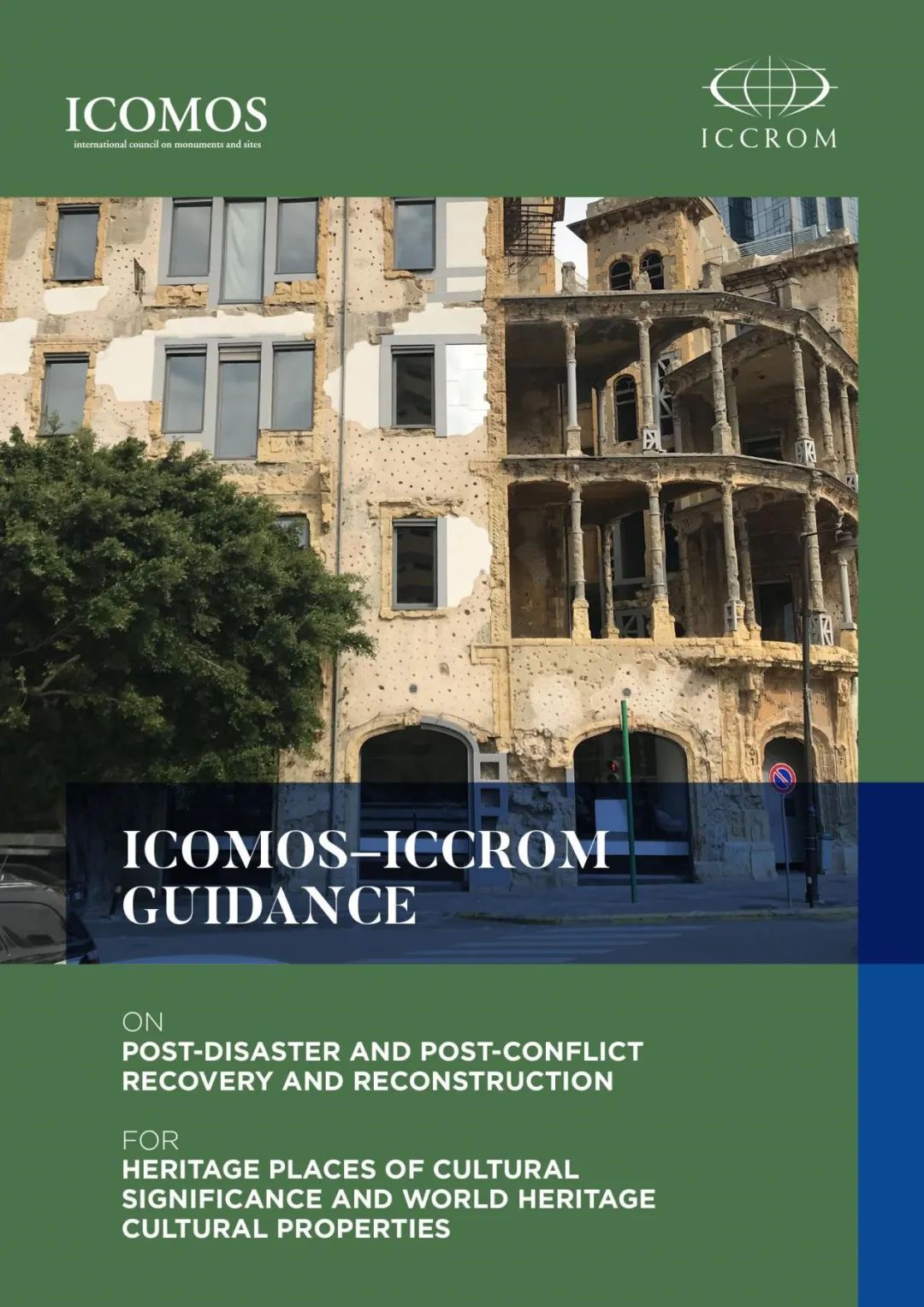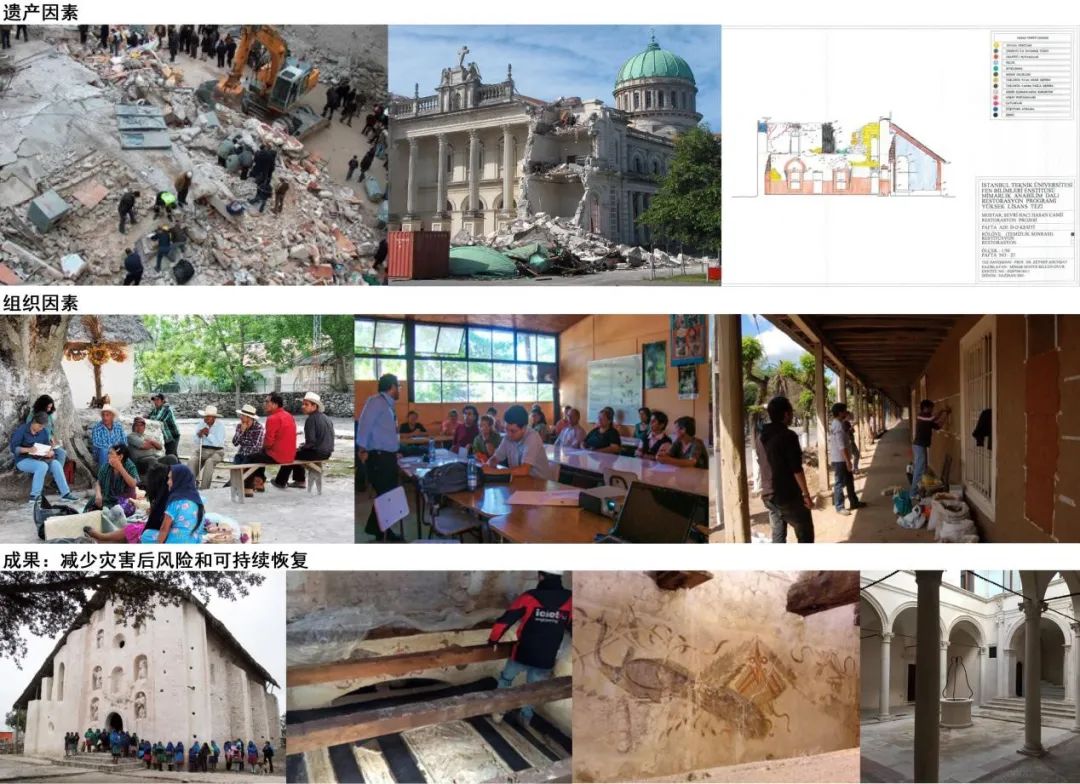书籍资料库
ICOMOS与ICCROM联合发布《关于灾后及冲突后恢复重建的指南》
ICOMOS与ICCROM联合发布
《关于灾后及冲突后恢复重建的指南》
ICOMOS-ICCROM GUIDANCE

图片来源:https://openarchive.icomos.org/id/eprint/3183/
一、指南发布
2024年2月,ICOMOS和ICCROM共同出版了《关于具有文化意义的遗产地和世界文化遗产灾后及冲突后恢复重建的指南》。该指南不仅根植于国际遗产保护机构的倡议,更是对ICOMOS和ICCROM于2021年联合发布的“恢复与重建案例研究分析”项目合作成果的进一步拓展与深化。指南构建了一个全面而系统的指导性框架,旨在为从事遗产保护工作的专家提供支持,强化文化遗产地在遭受灾难与冲突后的恢复重建工作,从而帮助工作者有效应对并克服相关破坏与损失所带来的挑战。
二、指南主要内容
在深入阐述指导原则、关键概念,并列举可持续恢复中的基本准则后,该指南进一步从“遗产因素”、“组织因素”以及“成果:减少灾害后风险和可持续恢复”三大核心维度,深入探讨了恢复过程中关键因素间的相互关联,并明确指出了从业者应当采取的行动措施。
“遗产因素”:指南针对灾难性事件发生前、中、后期不同时段文化遗产破坏影响的相关行为,详尽说明从业者所要进行的记录、评估等工作和重建策略,并对恢复重建规划战略的执行要点进行了指导说明。
“组织因素”:指南指出多方合作与协调的重要性,详细阐述了在遗产恢复重建行动中政府、非政府组织、专家学者、当地社区等多元行动者如何进行有效的协同合作。指南强调遗产的恢复重建工作应当注重提升公众参与度,以协助重建社会凝聚力、增强社区复原力,并为社会的可持续发展创造有利条件。
“成果:减少灾害后风险和可持续恢复”:指南提出需进行风险评估和灾难恢复计划的制定以及共享通信平台的构建。同时,指南强调将遗产纳入可持续保护发展计划,以确保遗产的长期保护和价值最大化。

图片来源:《关于具有文化意义的历史遗迹和世界文化遗产灾后及冲突后恢复重建的指南》
三、指南述评
《关于具有文化意义的遗产地和世界文化遗产灾后及冲突后恢复重建的指南》不仅为受损遗产的恢复重建工作提供了健全的决策程序,还通过一种注重环境的恢复方法,确保遗产地的重要性和世界遗产的突出普遍价值能够最大程度地延续。这一指南无疑为遗产保护工作提供了重要的指导和支持,更为遗产的可持续保护和发展作出了积极贡献。
下载地址
《关于具有文化意义的历史遗迹和世界文化遗产灾后及冲突后恢复重建的指南》
https://openarchive.icomos.org/id/eprint/3183/
更多详细信息参见
https://www.icomos.org/en/89-english-categories/home/137854-new-icomos-iccrom-guidance-on-post-disaster-and-post-conflict-recovery-and-reconstruction
Info
New ICOMOS-ICCROM Guidance on Post-Disaster and Post-Conflict Recovery and Reconstruction
ICOMOS-ICCROM GUIDANCE
1. Guidance Publication
The ‘Guidance on Post-Disaster and Post-Conflict Recovery and Reconstruction for Heritage Places of Cultural Significance and World Heritage Cultural Properties’ published by ICOMOS and ICCROM in February 2024 builds on the initiatives of ICOMOS and ICCROM and those of other bodies, and extends the collaboration of the ICOMOS–ICCROM Project ‘Analysis of Case Studies in Recovery and Reconstruction’, published in 2021. The guidance is intended for experts working in heritage conservation and provides a framework through which the recovery of heritage places can be supported and harnessed in coming to terms with and overcoming the trauma associated with destruction and loss.
2. Main Contents of the Guidance
After elaborating on the guiding principles, key concepts and principles for a sustainable recovery process, this guidance further illustrates the interrelationships between key factors in the recovery process from the following three aspects: ‘heritage factors’, ‘organizational factors’ and ‘outcomes: disaster risk reduction and sustainable recovery’, and identifies actions that practitioners should take.
‘Heritage factors’: The guidance provides a detailed description of the recording, evaluation and reconstruction strategies that practitioners need to undertake in response to behaviors associated with the destruction of cultural heritage across various time periods. It also provides guidance on the implementation points of the restoration and reconstruction planning strategy.
‘Organizational factors’: The guidance underscores the importance of multi-party cooperation and coordination, and elaborates on the ways in which various actors, including governments, non-governmental organizations, experts and scholars, as well as local communities, can effectively collaborate during heritage restoration and reconstruction operations. It also emphasizes that heritage restoration and reconstruction work should focus on helping to rebuild social cohesion, enhance community resilience, and create favorable conditions for sustainable social development, all while increasing public participation.
‘Outcomes: disaster risk reduction and sustainable recovery’: The guidance proposes the need to carry out risk assessment, formulate disaster recovery plans, and construct a shared communication platform. At the same time, it emphasizes integrating heritage into sustainable conservation and development plans to ensure long-term protection and maximize the value of heritage.

Picture:
3. Guidance Review
The ‘Guidance on Post-Disaster and Post-Conflict Recovery and Reconstruction for Heritage Places of Cultural Significance and World Heritage Cultural Properties’ not only provides sound decision-making processes for recovery and reconstruction, but also suggests a context-attentive recovery approach that enables the perpetuation of the significance of heritage places and Outstanding Universal Value of World Heritage properties to the greatest extent possible. Furthermore, it makes a positive contribution to the sustainable protection and development of heritage.
Download Link
https://openarchive.icomos.org/id/eprint/3183/
For More Details See
https://www.icomos.org/en/89-english-categories/home/137854-new-icomos-iccrom-guidance-on-post-disaster-and-post-conflict-recovery-and-reconstruction
Info

扫码关注
亚洲遗产管理学会
Asian Academy for
Heritage Management
